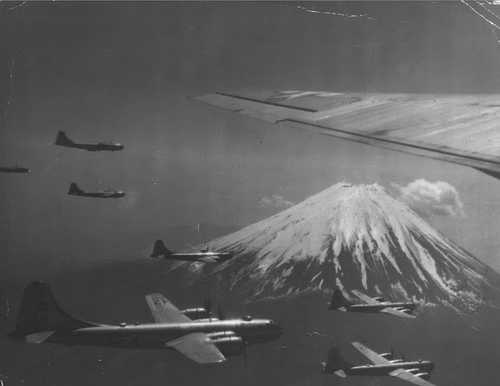
US Army Air Force
Going home ... B-29 Superfortresses.
Ken Stetson/LIFE magazine.
Boeing B-29 Superfortresses of 874 Bomb Squadron, 20th US Air Force, passes Mount Fuji as they return from burning down Nagoya, Japan, December 1944. The B-29 was probably the most advanced bomber of the war. Conceived and designed as a high-altitude, precision day bomber, its features included a fully pressurized cabin, heavy (for an aeroplane) armour, a fully automated, centralized defensive fire system operating through remote-controller turrets, long range, high stability and - last but not least - a heavy bomb load. In the event, this latest effort on the part of the US to produce an effective tool for precision day bombing proved no more successful, at least in those terms, than earlier ones. All, however, was not lost. As US forces closed in on Japan's home islands and captured bases within comfortable range of Japan, they switched the B-29's tactics to low-level operation, first at night, later in the day also. "Precision" bombing was also abandoned in favour of carpet-type bombing using high explosives and - in particular - incendiaries. This proved a great deal more effective at burning Japanese cities, including industrial assets and workers, to the ground than, I would suggest, the abortive bat bomb would have been. Mind you, the high-tech features of the B-29 could cause problems. The original author of this photo, Lieutenant (later Major) Ken Stetson, DFC, was flying the first of his thirty missions over Japan on the Nagoya raid. Early in the raid, the squadron encountered some Japanese interceptors, one of which landed a shell smack in his aircraft's centralized defensive fire control system, putting his remote controlled turrets out of action. The result was that any Japanese he encountered could shoot at him, but he could not shoot back. He later recalled this as a distinctly unpleasant experience; it did not prevent him from completing his mission, and flying home. Best regards, JR.
2902 Views
5/15/2014
